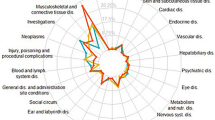Abstract
Antineoplastic drugs are one of the pharmacological classes more frequently involved in occurrence of “serious” adverse drug reactions. However, few epidemiological data are available regarding the preventability of adverse drug reactions with ambulatory cancer chemotherapy. We assessed the rate and characteristics of “preventable” or “potentially preventable” “serious” adverse drug reactions induced by oral protein kinase inhibitors (PKIs). We performed a retrospective study with all “serious” adverse drug reactions (ADRs) recorded from 1 January 2008 to 31 December 2009 in the French Pharmacovigilance Database with the eight oral protein kinase inhibitors marketed in France: sorafenib, imatinib, erlotinib, sunitinib, dasatinib, lapatinib, nilotinib and everolimus (Afinitor®) using the French adverse drug reactions preventability scale. This study was carried out on 265 spontaneous notifications. Most of adverse drug reactions were “unpreventable” (63.8 %). Around one third were “unevaluable” due to notifications poorly documented (medical history, dosage, use of drugs as first or second intention, concomitant drugs). One (0.4 %) adverse drug reaction was “preventable” with dasatinib (subdural hematoma) and three (1.1 %) were “potentially preventable” (hepatic adverse drug reactions): two with imatinib and one with sorafenib. For these four cases, we identified some characteristics: incorrect dosages, drug interactions and off-label uses. An appropriate prescription could avoid the occurrence of 1.5 % “serious” adverse drug reactions with oral PKIs. This rate is low and further studies are needed to compare our results by using other preventability instruments and to improve the French ADRs Preventability Scale.


Similar content being viewed by others
References
Castot A, Haramburu F, Kreft-Jaïs C (2008) Hospitalisations dues aux effets indésirables des médicaments: résultats d’une étude nationale Point sur la nouvelle campagne d’information sur les traitements anticoagulants antivitamine K. http://www.sante.gouv.fr/IMG/pdf/EMIR.pdf
Lau PM, Stewart K, Dooley M (2004) The ten most common adverse drug reactions (ADRs) in oncology patients: do they matter to you? Support Care Cancer 12:626–633. doi:10.1007/s00520-004-0622-5
Hoonhout LHF, de Bruijne MC, Wagner C et al (2010) Nature, occurrence and consequences of medication-related adverse events during hospitalization: a retrospective chart review in the Netherlands. Drug Saf 33:853–864. doi:10.2165/11536800-000000000-00000
Schwappach DLB, Wernli M (2010) Chemotherapy patients’ perceptions of drug administration safety. J Clin Oncol 28:2896–2901. doi:10.1200/JCO.2009.27.6626
Faye E, Bondon-Guitton E, Olivier-Abbal P, Bagheri H, Montastruc JL and The French Association of Regional Pharmacovigilance Centres (2011) “Serious” cutaneous reactions with protein kinase inhibitors. In: 15ème congrès de le Société Française de Pharmacologie et de Thérapeutique 22–24 March 2011; Grenoble; France
Faye E, Bondon-Guitton E, Olivier-Abbal P et al (2013) Spontaneous reporting of serious cutaneous reactions with protein kinase inhibitors. Eur J Clin Pharmacol. doi:10.1007/s00228-013-1532-6
Bowlin SJ (2012) Surveillance of drug metabolizing enzyme and transporter-based drug-drug interaction potential in patients receiving oral antineoplastic agents. In: 113th Annual Meeting of the American Society for Clinical Pharmacology and Therapeutics; 16 March 2012; Washington, Maryland, USA
Spreux A, Baldin B, Chichmanian RM (1999) Pharmacovigilance in practice. Transfus Clin Biol 6:254–259
Montastruc J-L, Sommet A, Lacroix I et al (2006) Pharmacovigilance for evaluating adverse drug reactions: value, organization, and methods. Joint Bone Spine 73:629–632. doi:10.1016/j.jbspin.2006.09.002
Edwards IR, Aronson JK (2000) Adverse drug reactions: definitions, diagnosis, and management. Lancet 356:1255–1259. doi:10.1016/S0140-6736(00)02799-9
Brown EG, Wood L, Wood S (1999) The medical dictionary for regulatory activities (MedDRA). Drug Saf 20:109–117
Bégaud B, Evreux JC, Jouglard J, Lagier G (1985) Imputation of the unexpected or toxic effects of drugs. Actualization of the method used in France. Therapie 40:111–118
Olivier P, Caron J, Haramburu F et al (2005) Validation of a measurement scale: example of a French Adverse Drug Reactions Preventability Scale. Therapie 60:39–45
European Medicines Agency (2013) Sprycel® dasatinib: summary of product characteristics. http://www.ema.europa.eu/docs/en_GB/document_library/EPAR_-_Product_Information/human/000709/WC500056998.pdf. Accessed 10 Jan 2014
European Medicines Agency (2014) Glivec® imatinib: summary of product characteristics. http://www.ema.europa.eu/docs/en_GB/document_library/EPAR_-_Product_Information/human/000406/WC500022207.pdf. Accessed 10 Jan 2014
Niwa T, Shiraga T, Takagi A (2005) Effect of antifungal drugs on cytochrome P450 (CYP) 2C9, CYP2C19, and CYP3A4 activities in human liver microsomes. Biol Pharm Bull 28:1805–1808
Pierfitte C, Bégaud B, Lagnaoui R, Moore ND (1999) Is reporting rate a good predictor of risks associated with drugs? Br J Clin Pharmacol 47:329–331
Van der Heijden PGM, van Puijenbroek EP, van Buuren S, van der Hofstede JW (2002) On the assessment of adverse drug reactions from spontaneous reporting systems: the influence of under-reporting on odds ratios. Stat Med 21:2027–2044. doi:10.1002/sim.1157
Hakkarainen KM, Andersson Sundell K, Petzold M, Hägg S (2012) Methods for assessing the preventability of adverse drug events: a systematic review. Drug Saf 35:105–126. doi:10.2165/11596570-000000000-00000
Bates DW, Cullen DJ, Laird N et al (1995) Incidence of adverse drug events and potential adverse drug events. Implications for prevention. ADE Prevention Study Group. JAMA 274:29–34
Bates DW, Leape LL, Petrycki S (1993) Incidence and preventability of adverse drug events in hospitalized adults. J Gen Intern Med 8:289–294
Thomas EJ, Orav EJ, Brennan TA (2000) Hospital ownership and preventable adverse events. Int J Health Serv 30:745–761
Gandhi TK, Weingart SN, Borus J et al (2003) Adverse drug events in ambulatory care. N Engl J Med 348:1556–1564. doi:10.1056/NEJMsa020703
Conflict of interest
The authors declare that they have no conflict of interest.
Author information
Authors and Affiliations
Corresponding author
Additional information
This work has been presented as an oral communication (1) and a poster (2) in 2012.
1. Egron A, Bondon-Guitton E, Olivier-Abbal P, Montastruc JL and the French Association of Regional Pharmacovigilance Centers. Preventability of “serious” adverse drug reactions induced by oral protein kinase inhibitors (PKIs). In: 7ème congrès de Physiologie, Pharmacologie et Thérapeutique (P2T); 4–6 avril 2012; Dijon; France.
2. Egron A, Bondon-Guitton E, Olivier-Abbal P, Montastruc JL and the French Association of Regional Pharmacovigilance Centers. Preventability of “serious” adverse drug reactions induced by oral protein kinase inhibitors (PKIs). In: 12th Annual Meeting of International Society of Pharmacovigilance (ISOP); 30 Oct–12 Nov 2012; Cancun; Mexico.
Rights and permissions
About this article
Cite this article
Egron, A., Olivier-Abbal, P., Gouraud, A. et al. Preventable and potentially preventable serious adverse reactions induced by oral protein kinase inhibitors through a database of adverse drug reaction reports. Targ Oncol 10, 229–234 (2015). https://doi.org/10.1007/s11523-014-0328-7
Received:
Accepted:
Published:
Issue Date:
DOI: https://doi.org/10.1007/s11523-014-0328-7



